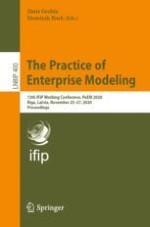This book constitutes the proceedings papers of the 13th IFIP Working Conference on the Practice of Enterprise Modeling, held in Riga, Latvia, in November 2020.
Due to the COVID-19 pandemic the conference took place virtually.
The 19 full papers presented together with 7 short and 2 invited papers in this volume were carefully reviewed and selected from a total of 58 submissions to the main conference. The special focus of PoEM 2020 is on the role of enterprise modelling in the digital age. The selected papers are grouped by the following topics: Enterprise Modeling and Enterprise Architecture, Formal Aspects of Enterprise Modelling, Foundations and Applications of Enterprise Modeling, Enterprise Ontologies, Business Process Modeling, Risk and Security Modeling, Requirements Modeling, and Process Mining.
